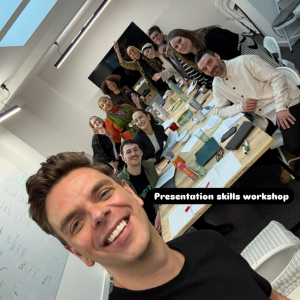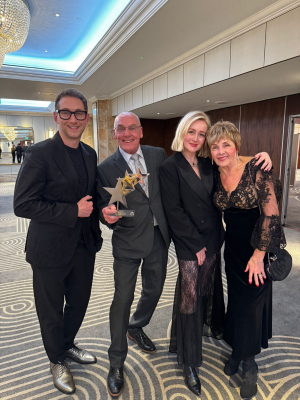-
.
Gareth Davies
Top 10 Proven Tips to Master Your Presentation Skills
Top 10 Proven Tips to Master Your Presentation Skills:
Presentations are a critical skill in both personal and professional settings. Whether you're presenting in a boardroom, at a conference, or in front of a classroom, the ability to effectively communicate your ideas can make a significant difference in your success. However, mastering presentation skills isn't something that happens overnight. It requires practice, reflection, and an understanding of various techniques. In this article, we’ll explore ten proven tips to help you enhance your presentation skills and truly engage your audience.
1. Develop Your Own Style. The most effective presenters are not the ones who mimic someone else’s delivery. They are the ones who have developed their own unique style. This is important because your style should reflect who you are and make you feel comfortable while presenting. Whether you're energetic and lively or calm and composed, your style should align with your personality and strengths. A presenter who is authentic is much more engaging and relatable. Trying to adopt someone else’s persona often feels forced and can distract both you and the audience from the message you're trying to convey. Take time to explore different methods of presenting. Once you discover your authentic presentation style, you’ll naturally feel more at ease and confident, which will resonate with your audience.
2. Make Sure Your Style Works with Your Brand. Your presentation style should not only reflect your personality but also fit within the context of your personal or professional brand. Whether you're an entrepreneur, a corporate leader, or a teacher, your presentation style communicates your values and enhances your credibility. For example, if you’re a startup founder pitching an innovative idea, you might opt for an enthusiastic, fast-paced delivery. On the other hand, if you're presenting a corporate strategy to senior executives, you may need to adopt a more formal and measured tone. It’s important to understand that your presentation style is an extension of your personal or company brand. It helps shape how your audience perceives you. Ask yourself: "Does my presentation style align with the message I’m trying to communicate and the brand I want to project?" Consistency is key. If your style contradicts your brand, it can cause confusion and undermine your credibility. So, before presenting, reflect on what you want your audience to remember about you and ensure your style supports that goal.
3. Keep It Short and Sweet. We live in an era of information overload, and people’s attention spans are shorter than ever. If you’re presenting a long, drawn-out speech, your audience will likely tune out. One of the most effective ways to keep your audience engaged is to keep your presentation short and focused. Condense your message to its core points, ensuring that everything you say serves a clear purpose. When preparing your presentation, ask yourself, "What are the key takeaways I want my audience to remember?" Once you’ve identified these core ideas, structure your presentation around them and avoid adding unnecessary filler content. Be concise, and respect your audience’s time by sticking to your allotted time limit. If you make your presentation clear and to the point, you’ll leave your audience with a more lasting impression.
4. Write a Script. Although some people may find it restrictive, writing a script for your presentation can help organize your thoughts and make sure you don't miss important details. A script can be particularly helpful when preparing for more formal presentations, such as business pitches, lectures, or public speaking engagements. When you write a script, you have the opportunity to choose your words carefully, ensuring that every phrase aligns with your main message. However, a script shouldn’t be a word-for-word memorization. Rather, it should serve as a guide. Once you’ve written your script, practice delivering it aloud until you’re comfortable with the flow of words and transitions. Even if you don’t stick to the script exactly, it will give you a solid foundation and make your delivery feel more polished. Another great advantage of writing a script is that it allows you to test different approaches. If one part of your presentation doesn’t feel right, you can rework it until it sounds natural and effective. Think of the script as a tool to refine your ideas, rather than a rigid rulebook.
5. Eye Contact Is the Best Way to Cheat Confidence. One of the most powerful ways to convey confidence during a presentation is through eye contact. Maintaining good eye contact helps establish trust and creates a sense of connection with your audience. It also signals that you are engaged and present in the moment. Eye contact doesn’t just help others see that you’re confident; it also helps you feel confident. If you struggle with nervousness, try focusing on a few friendly faces in the crowd and make sure to connect with each person briefly. By doing so, you'll appear more confident than you feel, and the audience will respond positively. It’s important to avoid looking at the floor, ceiling, or your notes for extended periods of time, as this can make you seem disconnected or unsure of yourself. While making eye contact is important, be mindful of overdoing it. Staring intensely at one person for the entire presentation can make them uncomfortable. Instead, try to rotate your gaze around the room to ensure you engage with everyone in the audience.
6. Find Light and Shade. When delivering a presentation, the emotional tone of your voice plays a crucial role in maintaining engagement. Just like light and shade create depth in visual art, varying your tone of voice adds richness and dimension to your message. If you speak in a monotonous tone, your audience may lose interest quickly. To keep people engaged, use changes in your voice to emphasize key points, highlight important ideas, and convey emotions effectively. For example, when you’re about to make an important point, slow down your speech and lower your tone. This builds anticipation and draws your audience’s attention. Conversely, if you're discussing something exciting or energizing, raise your voice slightly and quicken your pace. Playing with the dynamics of your voice will keep your audience on their toes, and they’ll be more likely to remember what you said. In addition to vocal tone, the use of pauses can create "shade" in your presentation. Pausing at strategic moments not only gives you time to collect your thoughts but also gives your audience time to process the information. A well-placed pause can add emphasis to a point and keep your listeners engaged.
7. Engage Your Audience with Stories. One of the most effective ways to connect with your audience is by telling stories. People remember stories far better than they remember statistics or data points. A well-told story helps humanize your presentation and makes your message more relatable. You can use stories to illustrate key concepts or to demonstrate real-world applications of your ideas. When telling a story, make sure it is relevant to your presentation. Your audience will respond positively to anecdotes that help clarify or support your main message. Stories also provide an opportunity to show vulnerability and connect emotionally with your listeners, which builds rapport and trust. A great way to integrate storytelling is to start your presentation with a compelling personal story or a case study that sets the tone for the entire presentation. This approach hooks your audience from the beginning and sets up your key messages in a memorable way.
8. Master Non-Verbal Communication. While your words are crucial, your body language is just as important in conveying your message. Your non-verbal communication can reinforce or undermine what you're saying, so it’s essential to be mindful of how you present yourself physically. Use purposeful gestures to emphasize important points and to engage with your audience. Avoid crossing your arms, which can make you seem closed off or defensive. Instead, keep your body open, stand tall, and move naturally around the stage or area where you're presenting. Use your face and body to communicate as much as your words do.
9. Rehearse Like a Pro. There’s no substitute for practice when it comes to perfecting your presentation skills. Rehearse your presentation several times before the actual event. The more you practice, the more comfortable you’ll feel, and the better your delivery will be. Rehearse in front of a mirror, record yourself, or present to a friend or colleague. This will help you spot areas where you might be tripping up or where you can improve. When rehearsing, pay attention to your timing. Make sure your presentation fits within the time limit, and practice pacing yourself so you don’t rush through key points. You’ll also want to rehearse your transitions between slides or topics, ensuring the flow of your presentation is smooth and seamless.
10. Handle Questions with Confidence. One of the most nerve-wracking parts of any presentation is the Q&A session. However, how you handle questions can be just as important as your actual presentation. Prepare for potential questions ahead of time by anticipating what your audience might ask. This will help you feel more prepared and less anxious. When responding to questions, listen carefully and give thoughtful, concise answers. If you don’t know the answer to a question, don’t be afraid to admit it. Honesty and humility will earn you respect from your audience. You can always offer to follow up later with more information. During the Q&A session, maintain the same level of engagement as during your presentation. This shows that you are confident in your message and willing to engage with your audience in a meaningful way.
Conclusion. Mastering your presentation skills takes time and practice, but with these ten proven tips, you can enhance your abilities and leave a lasting impression on your audience. Developing your own style, keeping your presentation concise, engaging with eye contact and stories, and rehearsing thoroughly will ensure that you’re well-prepared to deliver a compelling message. By focusing on both the verbal and non-verbal aspects of communication, you’ll be able to connect with your audience and convey your ideas with confidence.
For help with your presentations check out the presentation training courses we offer here at The Presenter Studio: https://www.presenterstudio.com/business-presenter-training/presentation-skills-training
How to Become a Good Public Speaker with No Experience
Public speaking can feel daunting, especially if you’ve never stepped onto a stage or addressed a crowd before.
The good news? You don’t need prior experience to become a confident and compelling speaker. With dedication, practice, and a few clever strategies, anyone can master the art of holding an audience’s attention.
Below, The Presenter Studio team shares some tips to help you on your journey to becoming a great public speaker, even if you’re starting from scratch.
Start off small
If the idea of speaking in front of a large group makes your palms sweat, don’t worry, you don’t have to dive straight into a keynote address. Begin with small, low-pressure settings.
Chat with a few friends or family members and ask for their feedback. Join a local club or group, like a book club or community meet-up, where you can share your thoughts in a relaxed environment. These baby steps will help you get comfortable with expressing yourself out loud, laying the groundwork for bigger audiences later.
Develop a structure
Good public speaking isn’t about winging it, but about structure.
Even without experience, you can craft a solid talk by following a simple formula: an engaging opening, a clear middle with key points, and a memorable close.
Start with a story, question, or surprising fact to hook your listeners. Then, organise your main ideas into three digestible points. People tend to remember things in threes.
Wrap up with a call to action or a thought-provoking takeaway. Practice this framework with everyday topics, like explaining a recipe or sharing a film review, to build your skills.
Learn from the pros
You don’t need to reinvent the wheel.
Watch TED Talks, stand-up comedy, or even local speakers at events to see what works. Pay attention to how they use pauses, vary their tone, and connect with the audience.
You’re not copying their style, think of it as gathering inspiration.
Note what grabs your attention and try mimicking those techniques in your own practice sessions. Over time, you’ll find your own voice while borrowing from the best.
Practice
There’s no shortcut here: practice is your golden ticket.
Record yourself speaking on your phone and play it back. It might feel awkward at first, but you’ll spot areas to improve, like cutting out “ums” or slowing your pace.
Try rehearsing in front of a mirror to work on your posture and gestures.
If you’re feeling brave, ask a trusted friend to listen and give honest feedback. The more you practice, the more natural it’ll feel when the real moment arrives.
Consider a course
If you’re serious about accelerating your progress, Public Speaking Courses can be a game-changer. These structured programmes offer expert guidance, practical exercises, and sometimes even a supportive group to practice with.
Look for local workshops or online options that suit your schedule and budget. While not essential, they’re a brilliant way to gain confidence and polish your skills with professional input.
Deal with nerves
Everyone gets nervous, it’s human.
The trick is to channel that energy into enthusiasm.
Before you speak, take slow, deep breaths to steady yourself. Visualise success: picture the audience smiling and clapping. Focus on your message, not your fear.
A handy tip? Find a friendly face in the crowd and imagine you’re just talking to them. With time, those butterflies will feel more like excitement than dread.
Connect with your audience
A great speaker doesn’t just talk at people, they talk to them.
Make eye contact, smile, and use simple, relatable language. Ask questions or share a quick anecdote to draw listeners in. Even with no experience, you can build rapport by being genuine. People don’t expect perfection; they want to feel your passion and authenticity.
Wrapping up
Becoming a good public speaker with no experience is entirely possible. It’s less about natural talent and more about persistence and preparation.
Start small, learn from others, practice relentlessly, and embrace every opportunity to grow. Before you know it, you’ll be the one captivating the room, no experience required.
Don’t forget that The Presenter Studio offers a range of presentation skills training courses designed to help you develop your voice and unique presentation style. Get in touch to learn more.
Presentation Skills Coaching - Kerb
A great business presenter coaching session for the team at KERB on presentation skills.
A tailor-made session all around finding your voice and building confidence in presentations.
It was a joy to work with the team. 12 clients. 4 hours. A packed session full of great learning around finding your voice, developing your own style, and working with the brand of Kerb.
Thanks everyone for making us feel so welcome and for so much great work!
Presentation Skills Course: Reviews
The reviews are in...
It's been another lovely week of amazing feedback from clients for the presentation skills and presenter coaching work we do at The Presenter Studio...
Here's just a couple of the direct messages we've received:
"The workshop took me out of my comfort zone and was a huge confidence booster for me. It has helped me overcome some of my own doubts and feelings around peoples perceptions of me and my capability to perform under pressure. ?? Self doubt is a crushing battle I face every day in the sales environment. I can now move forward with the fact the just being my authentic self is enough!"
"Hi Gareth, thanks again for a very enjoyable and engaging session yesterday. Without exception, everyone came away highly charged and hugely motivated."
Receiving messages like these remind us that we are much more than a presenter coaching business. We add value in so many different ways and well...we are rather proud of ourselves!
We work so hard to ensure each coaching session we run is bespoke to each company we work with. And so it's just so rewarding when the hard work pays off! To read more about our courses click here: https://www.presenterstudio.com/business-presenter-training/presentation-skills-training
#presentationskills #confidencebuilding
TV Choice Award - Gogglebox
Great night at the TV Choice Awards and another win for team Gogglebox for best entertainment show.
Why The Presenter Studio is the Best for Public Speaking
Why The Presenter Studio is the Best for Public Speaking
Public speaking is a skill that can transform careers, businesses, and personal confidence, yet many people struggle with nerves, delivery, and engagement. At The Presenter Studio, we don’t just teach public speaking—we revolutionize the way people approach it. Our expertise, bespoke training, and creative approach make us the best choice for anyone looking to master the art of communication.
With over 20 years of experience working with some of the world’s top presenters, we bring insider knowledge from the world of TV and media into public speaking training. This means our clients learn techniques that real professionals use to engage, captivate, and influence audiences. We don’t rely on outdated, corporate-style training; instead, we use dynamic, modern methods tailored to the individual.
One of the key reasons we stand out is our bespoke training approach. No two speakers are the same, and neither should their training be. We work closely with clients to understand their unique strengths, challenges, and brand voice. Whether you’re preparing for a keynote speech, a business pitch, or a media appearance, we craft a strategy that ensures you deliver with confidence and impact.
At The Presenter Studio, we also believe that public speaking is a creative opportunity, not just a technical skill. Too often, public speaking training focuses solely on structure and clarity, neglecting the creativity and personality that make a speaker truly memorable. We help our clients infuse their presentations with authenticity, storytelling, and engagement techniques that leave a lasting impression.
Additionally, we understand that nerves can be a huge barrier to success. That’s why we incorporate confidence-building techniques into our training. From body language to vocal coaching to mindset strategies, we equip our clients with the tools they need to overcome anxiety and project self-assurance, even in high-pressure situations.
Our track record speaks for itself. We have helped business leaders, entrepreneurs, creatives, and professionals from all industries elevate their public speaking skills. Whether it’s refining message delivery, perfecting stage presence, or simply helping speakers find their voice, our tailored approach ensures maximum results.
The Presenter Studio is not just about helping people speak better—it’s about empowering individuals to connect, inspire, and make an impact. Public speaking should be an exciting opportunity, not a dreaded obligation, and with our unique training methods, we help our clients turn nerves into confidence and ideas into powerful presentations. Check out what we offer here: https://www.presenterstudio.com/business-presenter-training/presentation-skills-training
How to Fake Confidence in Media Training
How to Fake Confidence in Media Training
Confidence is one of the most crucial elements of successful media appearances, but not everyone naturally exudes it. The good news is that confidence can be faked – and with the right techniques, it can feel just as authentic as the real thing. Media training isn't just about knowing what to say; it’s about how you say it, and that’s where mastering the art of projecting confidence can make all the difference.
The first step is mastering body language. Even if you're feeling nervous, standing tall, making steady eye contact, and using open gestures can create the illusion of confidence. These small physical adjustments trick both your audience and your own mind into believing you are in control.
Another technique is to slow down your speech. Nerves often make people speak too quickly, which can come across as uncertainty. A steady pace, combined with intentional pauses, exudes composure and allows your message to land more effectively.
Breathing techniques play a vital role in appearing confident. Controlled breathing not only calms nerves but also ensures that your voice remains strong and steady. Deep breaths before and during an interview help regulate your nervous system and maintain a composed demeanor.
Rehearsal is key to faking confidence. The more you practice, the more natural your delivery becomes. Familiarizing yourself with your key points reduces uncertainty and ensures you come across as polished and prepared.
Another strategy is to embrace a confident mindset. Visualization techniques, where you imagine yourself succeeding in the interview, can positively influence your actual performance. Additionally, using power poses before going on air can help reinforce feelings of confidence.
Engaging with your interviewer and actively listening also demonstrates self-assurance. Rather than rushing to answer, take a moment to process questions, showing that you are thoughtful and in control of the conversation.
Finally, adopting a positive and assured tone of voice can make a world of difference. Even if you're unsure, speaking with conviction will make you appear more credible and self-assured. Practicing vocal variety—adjusting pitch, volume, and emphasis—can add further confidence to your delivery.
At The Presenter Studio, we help individuals master these techniques so they can project confidence in any media scenario. Whether you're stepping into a live interview or facing a challenging press situation, our training ensures you can command the moment with ease. Check out our website for more info: https://www.presenterstudio.com/business-presenter-training/media-training
Why We Set Up The Presenter Studio: Transforming Presentation Skills Training
Why We Set Up The Presenter Studio: Transforming Presentation Skills Training
Presentation skills training has long been stuck in a cycle of outdated techniques, generic courses, and uninspiring delivery. It’s an industry that has often felt grey, corporate, and lacking in creativity. That’s exactly why we created The Presenter Studio – to revolutionize how businesses and individuals approach presentations.
We saw a gap in the market for something fresh, modern, and impactful. With over 20 years of experience working with some of the world’s top presenters, we know that great presentations are not just about standing up and speaking clearly. They’re about storytelling, creativity, and delivering a message that connects.
In today’s fast-paced world, audiences expect more than just slides and a monotone voice. They want engagement, authenticity, and impact. The traditional methods of presentation training simply don’t cut it anymore. We stay ahead of the curve, incorporating the latest trends in communication, media, and branding. Our training is designed for the digital age – whether it’s presenting in-person, on video, or for social media. We help businesses and individuals develop a style that resonates today, not ten years ago.
No two presenters are the same, and no two businesses have the same needs. That’s why we don’t believe in a one-size-fits-all approach. Our training is completely bespoke, crafted to fit your brand, message, and personality. We work closely with clients to understand their unique challenges and goals, ensuring they walk away with a presentation style that feels authentic and impactful. Whether you’re a CEO, a startup founder, or a creative professional, we tailor our training to bring out the best in you.
Our approach is rooted in real-world experience. We’ve spent over two decades working with some of the biggest names in broadcasting, media, and business. From TV presenters to keynote speakers, we’ve helped professionals across industries craft compelling presentations that captivate audiences. This expertise allows us to bring insider knowledge, industry insights, and tried-and-tested techniques to our training. We know what works – and we know how to help you make an impact.
Let’s face it: traditional presentation training is often dull, rigid, and lacking in personality. We set up The Presenter Studio to break that mold. We believe presentations are a creative opportunity, not a chore. They should be dynamic, exciting, and memorable. Our approach brings energy, innovation, and a fresh perspective to an industry that desperately needs it. By challenging the outdated norms of presentation training, we help clients create something that stands out – whether it’s a pitch, a speech, or a company-wide address.
Your presentation is an extension of your brand. It’s not just about delivering information – it’s about making a lasting impression. Yet, many businesses fail to see presentations as an opportunity to do something unique and on-brand. We help our clients transform their presentations into powerful brand assets. Whether it’s refining the tone of voice, integrating visual storytelling, or ensuring consistency with brand messaging, we show businesses how to turn presentations into a powerful tool for engagement and impact.
The Presenter Studio was born out of a passion for change. We wanted to create a training experience that was dynamic, relevant, and tailored to the modern world. With our expertise, bespoke approach, and fresh perspective, we’re helping businesses and individuals redefine what it means to present with impact. If you’re ready to shake up the way you present, we’re here to help.
Public Speaking Courses: Why Conversation Beats Performance
Public Speaking Courses: Why Conversation Beats Performance
Public speaking can feel daunting, but the best speakers don’t just talk at their audience—they have a conversation with them. Too often, people think they need to put on a performance, delivering a perfectly rehearsed speech. But in reality, audiences connect most with speakers who feel natural, engaging, and real.
Why Speaking At an Audience Doesn’t Work
Many public speaking courses focus on rigid techniques—perfect posture, scripted pauses, and dramatic intonation. But this can make speakers feel robotic and disconnected from their audience. When a talk feels too rehearsed, people stop listening. Instead of engaging, they tune out.
The Power of Conversation
Think about your best conversations with friends or colleagues. You’re relaxed, you make eye contact, and you respond naturally. That’s the same approach you should take in public speaking. A natural, conversational tone helps you engage with your audience rather than just delivering a monologue. It allows you to react to the energy in the room and adapt as you go. When you focus on having a conversation rather than delivering a speech, you come across as more authentic and relatable.
How to Make Your Public Speaking More Conversational
Ditch the overly scripted speech and focus on knowing your key points rather than memorising every word. Speak in everyday language, just as you would in real life, rather than relying on overly formal phrases. Engage with your audience by making eye contact, responding to their reactions, and creating a sense of connection. Most importantly, be yourself. The best speakers embrace their own style rather than trying to fit into a mould.
At The Presenter Studio, we focus on helping people develop a natural, engaging speaking style that feels right for them. If you want to improve your public speaking skills, our courses will help you connect with audiences in a way that’s authentic and powerful. Check out our presentation skills courses here: https://www.presenterstudio.com/business-presenter-training/presentation-skills-training
Presentation Skills Course: The Power of a Well-Written Script
Presentation Skills: The Power of a Well-Written Script
A great presentation isn’t just about delivery—it starts with a strong script. Whether you’re speaking on stage, in a meeting, or on camera, the words you choose shape how your audience engages with your message. Yet, many people fall into the trap of writing scripts that are too long, too formal, or simply uninspiring. Here’s how to craft a script that makes an impact.
Keep It Short and Sharp
Attention spans are shorter than ever, so your script needs to be clear and concise. Long-winded explanations lose people fast, while a focused and to-the-point script keeps them engaged. Every sentence should serve a purpose—if it doesn’t add value, cut it.
Write How You Speak
A big mistake many presenters make is writing in a way that sounds impressive on paper but unnatural when spoken aloud. If you wouldn’t say it in real life, don’t put it in your script. Use simple, conversational language that feels authentic to you. This will help you sound more confident and connect better with your audience.
Excite and Engage Your Audience
Nobody wants to sit through a dull presentation. Look for ways to bring energy and personality into your script—use storytelling, humor, or interesting facts to grab attention. Think about your audience: What will make them lean in and want to hear more? If you’re excited about your topic, they will be too.
At The Presenter Studio, we help people craft scripts that sound natural, engaging, and impactful. If you want to improve your presentation skills, get in touch—we’d love to help you stand out. Check out our presentation skills course here: https://www.presenterstudio.com/business-presenter-training/presentation-skills-training











